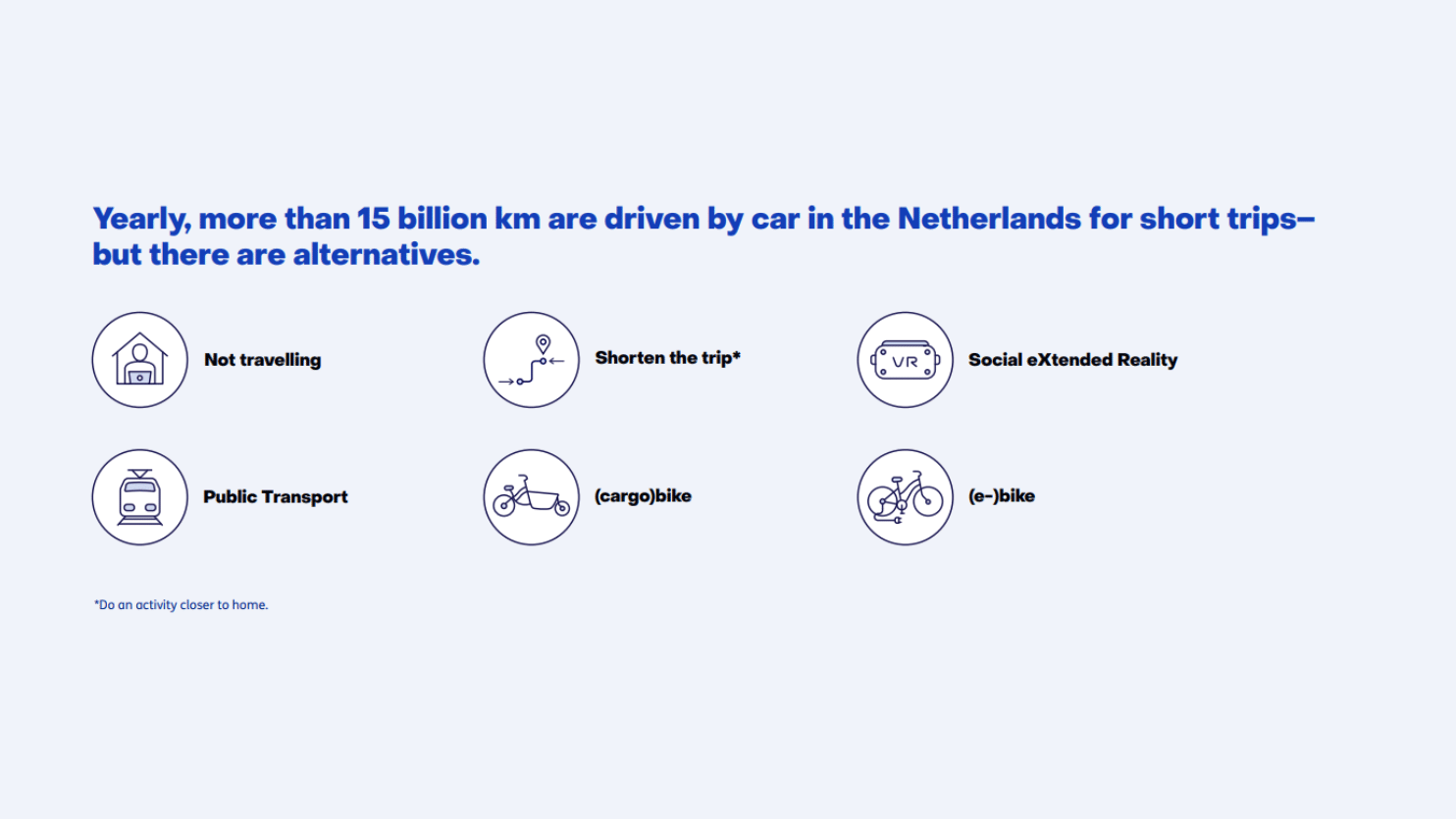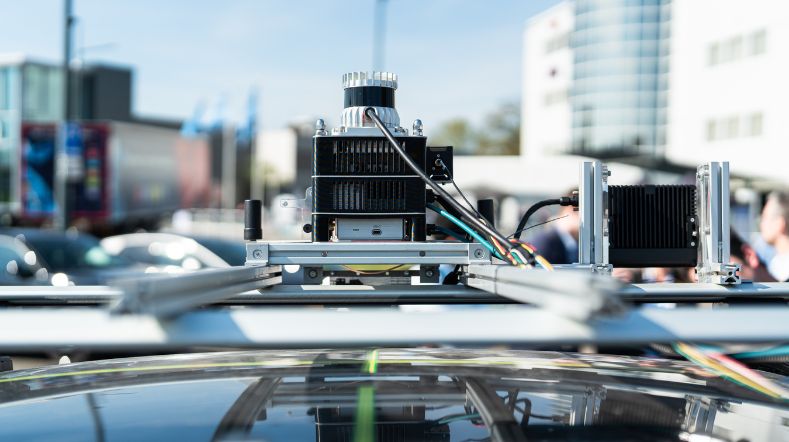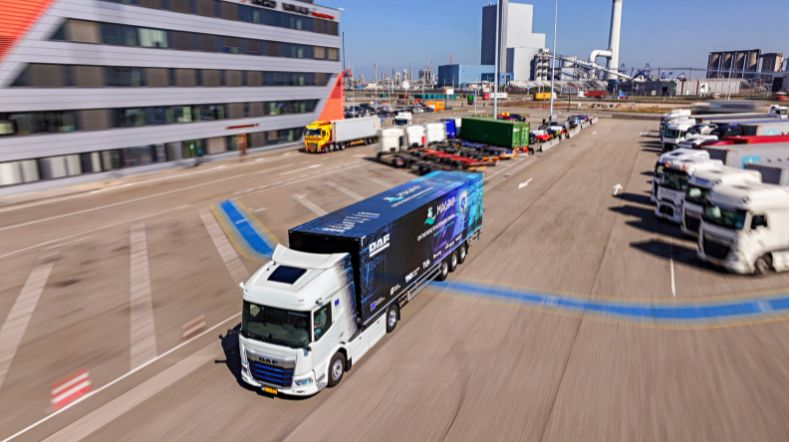
Sustainable travel alternatives, driven by data
Road transport currently accounts for around 37% of total emissions. Achieving our goals for a greener tomorrow requires change on every level. Changes to regulation, to infrastructure, and to our behaviour. But as governments and policymakers aim to reduce personal automobile usage, how can they make decisions that citizens are most likely to accept and adopt? In the SATA Project, TNO and the Royal Dutch Touring Club (ANWB) discovered that most people are willing to change their behaviour: but some very specific conditions apply.
Partnership with ANWB
The initial idea for the project emerged from one of TNO’s ‘Dragons’ Den’-style competitions. Two teams from the unit Mobility & Built Environment pitched ideas about smart transport solutions and more attractive public transport, and the jury declared them both to be winning ideas.
‘They asked us to combine the ideas into a single concept: explore the potential for more sustainable travel by offering smart and attractive alternatives, focusing specifically on the motivations and barriers that influence the adoption of these alternatives. We received the €100,000 prize to conduct our research as a Knowledge Investment Project,’ explains Eleni Charoniti, Medior Mobility Scientist at TNO.
One of the Dragon’s Den jury members happened to be the CEO of ANWB: the Netherlands’ largest association for traffic and tourism. On behalf of its nearly five million members, ANWB offers everything from roadside assistance to insurance to travel advice.
‘Our CEO recognised the opportunity to join forces and gain better insight into the motivations behind – and barriers to – more sustainable travel behaviour, which we can use to inform policymakers of key factors for success,’ says Geordie Kooiman, Public Affairs Advisor for ANWB. And thus, the Smart & Attractive Travel Alternatives (SATA) project was born.

"Uncovering the most appealing alternatives to car travel is a significant step towards inspiring drivers to change their behaviour."
99% of respondents willing to consider sustainable transport alternatives
The concept of ‘more sustainable travel’ comes in many forms, from using more sustainable modes of transport to choosing destinations closer to home. Or, even not traveling at all, by using online resources at home. ‘Results from our survey showed that 99% of respondents were willing to consider alternatives, at least for one of their types of travel. This re-emphasised the idea that it’s not necessary to change travel behaviour across the board, or across all reasons for travel. If every person chose alternatives for one trip they make, we can already make significant progress,’ says Isabel Wilmink, Senior Scientist and Knowledge Manager, Liveable and Resilient Cities at TNO.
Results of the SATA survey revealed that travel time was consistently the most important factor in a person’s choice of transportation. Convenience, cost, the type of activity (work, leisure, shopping, etc) and availability were also strong factors.
‘People were also more likely to choose alternatives for travel to work if offered incentives from their employer (like free public transport passes or bike schemes),’ Eleni continues. ‘But those same people were less likely to choose these alternatives for travel in their leisure time.’

Smart & Attractive travel alternatives for a greener tomorrow
Find out how people are open to changing their transportation behavior under specific conditions. Download the infographic to see the results related to sustainable transportation alternatives.
Transport alternatives: sustainable and attractive
But in order to enable long-term, sustainable change, current travel behaviour is certainly not the only area of focus. Policymakers must carefully consider the impact of their decisions. ‘SATA made it perfectly clear – the concept of “mobility” isn’t a singular idea with a straight-line solution,’ Geordie explains.
‘Individuals make different choices, at different times, when their trip is for different purposes. The systems we design must take into account these personal motivations if we want people to use them. It's not about telling them to sell their cars. It’s about making convenient, attractive alternatives available, so that they leave their cars at home and choose more sustainable options for the journeys for which they’re willing to do so.’
Secondly, the alternatives offered need to not only be sustainable, but also attractive. ‘Public transport was less likely to be chosen for the majority of activities, and respondents cited lack of frequency and reliability as two of the primary reasons why,’ Isabel says.
‘Improving the quality and accessibility of public transport could go a long way. We noted, for example, that elderly travellers were more likely to use public transport, but younger travellers consider it too unreliable and inconvenient.’
"Most important to ANWB is that we want to encourage our members to change certain behaviours, but not to force them to do so. Understanding their motivations will help us shape alternatives that are really attractive."
Future sustainable mobility
In addition to supporting ANWB’s advice to decision-makers in this domain, the data from the SATA survey will be used in TNO’s Digital Twin systems, with which stakeholders can view the actual, data-driven effects of infrastructure decisions on the living environment. But Eleni, Isabel and Geordie agree that there’s plenty more work to do. ‘The survey revealed details that are well worth exploring further,’ Isabel emphasises.
‘For example, there are certain people who love their cars and struggle to give them up. There are also people that feel that a car is their only viable option for certain journeys. By exploring issues like these on a deeper level, we can uncover ways to remove barriers and make the transition to alternative travel more accessible.’
Geordie adds that gathering more data will also provide better support for projects already underway and those being considered. ‘The greater and more robust the data, the more specifically we can target the challenging barriers and utilise the biggest motivators,’ she says.
The extensive analysis of SATA data revealed a wealth of additional information not covered in this article. Want to learn more, or are you eager to contribute to efforts to reduce car dependency and encourage more sustainable travel? Get in touch with TNO to see how you can help.
SATA survey results
The SATA survey revealed participants’ willingness to switch to travel alternatives like online shopping (60%), working from home (58%) or using an e-bike to attend leisure activities (50%). This indicates that the trip purpose has a strong influence on travel behaviour.
About SATA
The SATA project utilised the expertise and resources of both TNO and ANWB in the most optimal ways. TNO organised the project, establishing work packages and communication channels. They also tapped into TNO expertise for the right way to formulate the research questions and answer options to achieve the most statistically sound results.
ANWB offered an expert researcher, project support and access to ANWB’s Mobility Panel – a group of 17,000 ANWB members who volunteer to contribute to studies like these. Together, the SATA team analysed the survey answers and gained useable insights for further analysis. All team members are eager to continue their research for deeper understanding of this complex issue.
Get inspired
Releasing autonomous software faster with DeepScenario and TNO’s StreetWise


MARQ opens its doors: a place to collaborate on the mobility of the future


Fuel cells crucial for decarbonising heavy-duty transport and non-road machinery


Health of electric bus batteries now measurable on-site via charger


Demonstrations of automated driving and charging for logistics at Maasvlakte




